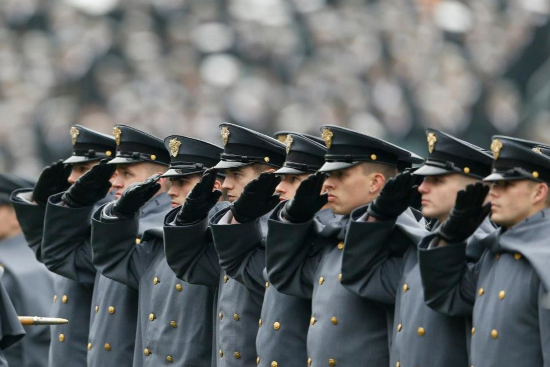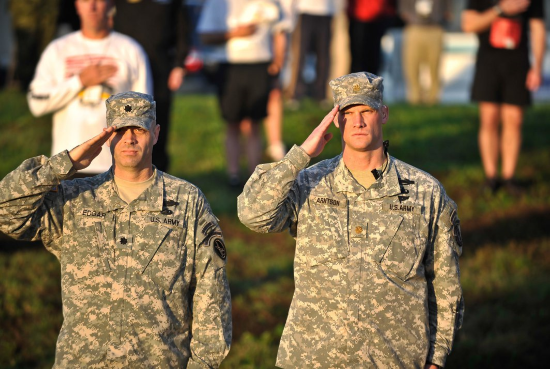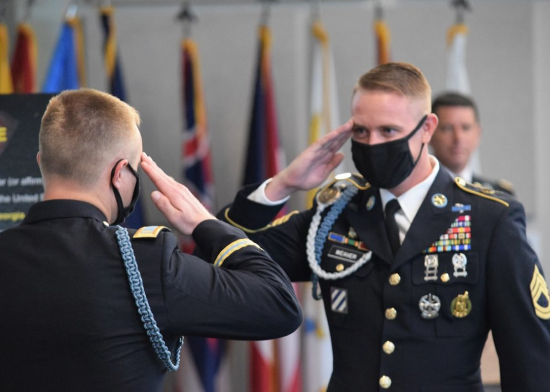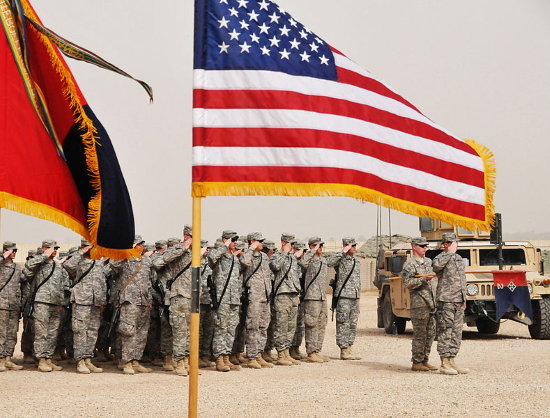A proper salute in the military is an important part of professional customs and courtesies, giving the gesture more meaning than just its physical action.
The military salute is a formal acknowledgement of respect and honor given at attention as a public sign in recognition of a superior officer’s rank.
Overall, military members salute by bringing their right hand to the brim of their cap or to a point slightly above their right eye.
It is essential to know how to properly salute in the military in greeting, leaving, reporting, and other circumstances.
Related Article – 31 Presidents That Served In The Military (& 15 That Didn’t)
Table of Contents
Origins Of Military Salute

Many historians believe that the tradition of military salute originated during the Roman Empire, as a means of presenting a friendly, unarmed greeting.
This gesture of trust has taken many forms and has been incorporated into many organizations and militaries across the world.
In the U.S. military, the salute is a visible sign of respect and recognition of military rank and leadership.
Therefore, the customary way of showing recognition and respect for officers of superior rank in the Armed Forces is to salute them.
Protocol For Military Salute
Commissioned officers and warrant officers are to be saluted by lower-ranking military members when appropriate.
Others to be saluted are the President of the United States, Medal of Honor Recipients (regardless of rank), and officers from other (friendly) nations.
To properly salute in the military, there are protocols that must be followed:
- Lower-ranking or junior members initiate the salute, not the senior member
- Military members salute when in uniform
- Civilians, military members not wearing headgear, and those in civilian clothing do not salute and are not saluted
- It is inappropriate to salute with items held in the saluting hand or in the mouth
When indoors, it is the protocol to not salute superior officers with one exception.
When a member of the military is ordered to report to a superior officer indoors, they are to salute with or without headgear.
During combat, the tradition of saluting may be suspended to avoid the identification of higher-ranking members on the battlefield.
Situations That Require A Salute

Certain circumstances require a salute from uniformed service members.
These situations include:
- Playing of National Anthem, “To the Color,” “Hail to the Chief,” or foreign national anthem
- During outdoor recitation of the Pledge of Allegiance
- Ceremonial occasions (changes of command, military funeral, etc.)
- Reveille and retreat/to the color ceremonies (when the American flag is raised or lowered)
- Sounding of honors
- Turning over control of formations
- Reporting to a superior officer
- Display of uncased National Colors outdoors
- Officers in official vehicles (identified by grade, vehicle plates, and/or flags)
Ultimately, in addition to these circumstances, a military member in uniform salutes when they meet and recognize an officer as entitled by their rank.
Except in inappropriate or impractical situations, saluting is the professional and respectful way of acknowledging a superior officer.
How To Properly Salute
A proper military salute is considered a sharp, one-count movement.
When performing a salute, the right hand is raised sharply with the fingers and thumb joined and extended.
The palm should be facing down.
The tip of the right forefinger should be placed at the rim of the headgear visor, just slightly to the right of the right eye.
The outer edge of the hand should be held slightly downward such that the back of the hand and the palm are neither clearly visible from the front.
The hand and wrist must be straight with the elbow held slightly forward and the upper arm kept in a horizontal position.
The salute should end with the right hand sharply returned to the person’s side.
For members of the military, saluting becomes almost a reflex that is swift, immediate, and crisp.
This allows subordinates and senior officers to make this professional gesture a sign of reciprocal respect.
Misinterpretations Of Military Salute

The military salute is often misinterpreted and misunderstood among those outside the military.
A salute is not a gesture of subservience or submissiveness on the part of junior service members toward senior officers.
Instead, it is an expression of recognition on behalf of both parties, junior and senior, as members of the profession of arms.
Military salutes are prescribed by regulation.
However, when a junior service member extends a salute, it is a form of etiquette and it is to be met with a salute in return as recognition of military respect, trust, and professionalism.
Related Article – Marine Corps General Orders
Conclusion
Military customs and courtesies, such as the salute, are signs of honor and respect.
They are an important part of each branch of the U.S. Armed Forces.
The military salute reflects mutual respect, proper manners, politeness, professionalism, and discipline.
In addition, the salute is an outward sign of respect for the United States, its flag, military comrades, and fallen heroes.
Like many military customs and courtesies, the salute publicly demonstrates a commitment to duty, honor, and country.
In addition, it is a professional standard of conduct and a symbol of honor and respect among all military service members.
- Ikon Pass Military Discount: Learn How To Save Big - January 31, 2025
- RTIC Military Discount: Find Out How To Save Big on Gear - January 30, 2025
- Traeger Military Discount: Learn How To Save Big on Smokers - January 28, 2025




